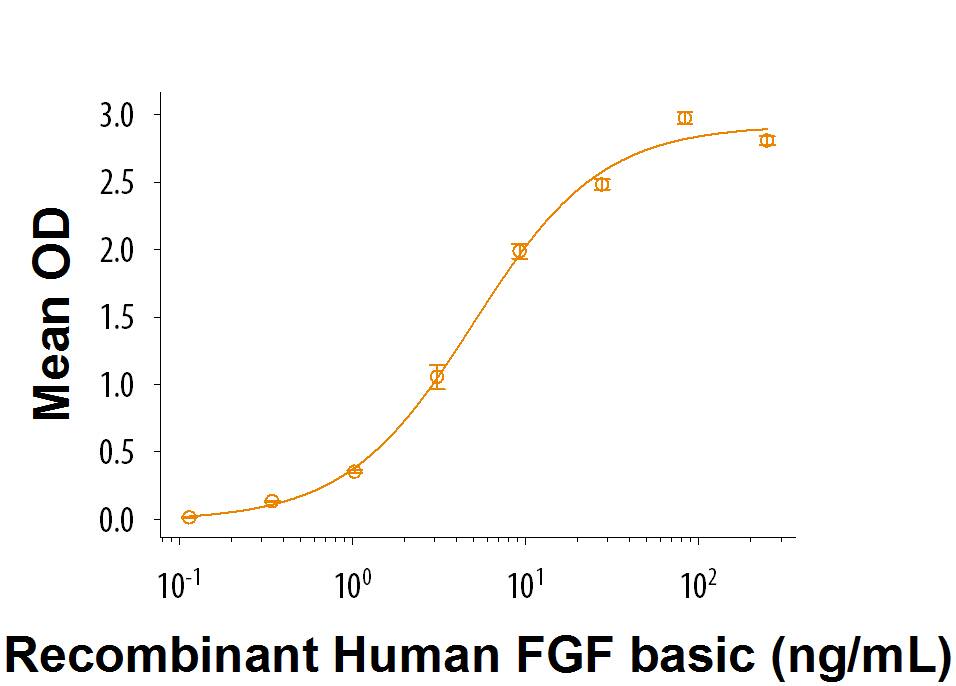Recombinant Mouse Glypican 6 Fc Chimera Protein, CF
R&D Systems, part of Bio-Techne | Catalog # 9429-GP

Key Product Details
Source
NS0
Accession #
Structure / Form
Disulfide-linked homodimer
Conjugate
Unconjugated
Applications
Bioactivity
Product Specifications
Source
Mouse myeloma cell line, NS0-derived mouse Glypican 6 protein
| Mouse Glypican 6 (Asp24-Val513) Accession # Q9R087 |
IEGRMD | Human IgG1 (Pro100-Lys330) |
| N-terminus | C-terminus |
Purity
>95%, by SDS-PAGE visualized with Silver Staining and quantitative densitometry by Coomassie® Blue Staining.
Endotoxin Level
<0.10 EU per 1 μg of the protein by the LAL method.
N-terminal Sequence Analysis
Asp24 & Ser355
Predicted Molecular Mass
83 kDa (Asp24-Val513/mFc), 44 kDa (Ser355-Val513/mFc) and 38 kDa (Asp24-Arg354)
SDS-PAGE
84-98 kDa (Asp24-Val513/mFc), 53-68 kDa (Asp24-Val513/mFc) and 33-40 kDa (Asp24-Arg354)
Activity
Measured by its binding ability in a functional ELISA.
When Recombinant Mouse Glypican 6 Fc Chimera is immobilized at 3 μg/mL, 100 μL/well, the concentration of Recombinant Human FGF basic 146 aa (Catalog # 233-FB) that produces 50% of the optimal binding response is 2.5-15 ng/mL.
When Recombinant Mouse Glypican 6 Fc Chimera is immobilized at 3 μg/mL, 100 μL/well, the concentration of Recombinant Human FGF basic 146 aa (Catalog # 233-FB) that produces 50% of the optimal binding response is 2.5-15 ng/mL.
Scientific Data Images for Recombinant Mouse Glypican 6 Fc Chimera Protein, CF
Recombinant Mouse Glypican 6 Fc Chimera Protein Bioactivity
When Recombinant Mouse Glypican 6 Fc Chimera (Catalog # 9429-GP) is immobilized at 3 µg/mL, 100 µL/well, Recombinant Human FGF basic 146 aa (Catalog # 233-FB) binds with an ED50 of 2.5-15 ng/mL.Formulation, Preparation and Storage
9429-GP
| Formulation | Lyophilized from a 0.2 μm filtered solution in PBS. |
| Reconstitution |
Reconstitute at 500 μg/mL in PBS.
|
| Shipping | The product is shipped at ambient temperature. Upon receipt, store it immediately at the temperature recommended below. |
| Stability & Storage | Use a manual defrost freezer and avoid repeated freeze-thaw cycles.
|
Background: Glypican 6
References
- Song, H.H. and J. Filmus (2002) Biochim. Biophys. Acta 1573:241.
- Filmus, J. (2001) Glycobiology 11:19R.
- De Cat, B. and G. David (2001) Semin. Cell Dev. Biol. 12:117.
- Filmus, J. (2003) Glycoconj. J. 19:319.
- Veugelers, M. et al. (1999) J. Biol. Chem. 274:26968.
- Paine-Saunders, S. et al. (1999) Genomics 57:455.
- Kirn-Safran, C. et al. (2009) Cell. Mol. Life Sci. 66:3421.
- Syrokou, A. et al. (1999) Cell Prolif. 32:85.
- Dinccelik-Aslan, M. et al. (2015) Mol. Clin. Oncol. 3:584.
- Yiu, G.K. et al. (2011) Biochem. J. 440:157.
- Melleby, A.O. et al. (2016) PLoS One. 11:e0165079.
Alternate Names
GPC6
Gene Symbol
GPC6
UniProt
Additional Glypican 6 Products
Product Documents for Recombinant Mouse Glypican 6 Fc Chimera Protein, CF
Product Specific Notices for Recombinant Mouse Glypican 6 Fc Chimera Protein, CF
For research use only
